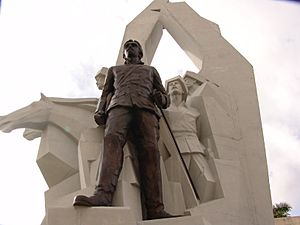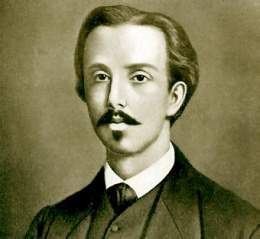Ignacio Agramonte facts for kids
Quick facts for kids
Ignacio Agramonte
|
|
|---|---|

Statue of Ignacio Agramonte on the Plaza de Revolución in Camagüey
|
|
| Born | December 23, 1841 Puerto Príncipe (now Camagüey), (Cuba)
|
| Died | May 11, 1873 Jimaguayú, Cuba
|
Ignacio Agramonte y Loynaz (born December 23, 1841 – died May 11, 1873) was a brave Cuban revolutionary. He played a very important role in Cuba's fight for independence, known as the Ten Years' War (1868–1878).
Contents
Ignacio Agramonte's Early Life
Ignacio Agramonte was born in Puerto Príncipe, which is now called Camagüey, on December 23, 1841. He came from a wealthy family. His father, also named Ignacio Agramonte, was a city council member.
Education and Marriage
Young Ignacio studied law at universities in Barcelona, Madrid, and Havana. He became a lawyer on June 11, 1865.
After his studies, he returned home. In August 1868, he married Amalia Simoni y Argilagos. She was the love of his life.
Agramonte's Appearance
Ignacio Agramonte was a tall man, about 6 feet 2 inches. He had fine brown hair and pale skin. He was also very skilled at riding horses and fencing.
A Leader in the Fight for Freedom
When the war for independence against Spain began on October 10, 1868, Ignacio Agramonte quickly became involved. He helped lead the uprising in Camagüey on November 4, 1868. Just a week later, on November 11, 1868, he officially joined the war.
His Wife's Role
His wife, Amalia, also supported the fight. However, she was captured by Spanish forces on May 26, 1870. She was pregnant at the time. Her second child was born in the United States and never got to meet his father.
A Strong Voice for Independence
Even though he came from a privileged background, Agramonte became one of the strongest leaders in central Cuba. He believed that Cuba had only one choice: to break free from Spain by fighting. He once said that Cuba must "gain its redemption by tearing itself from Spain through armed force."
Early Political Roles
In February 1869, Agramonte was chosen as a secretary for the rebel government. He also became a member of the Cuban Congress in Arms. He was one of five people who signed a document to end slavery in the Camagüey area on February 26, 1869.
Agramonte was a key person in writing the Guáimaro Constitution. This was the first constitution created by the Cuban rebel government, passed on April 10, 1869.
He later resigned from his government positions. This was because he had strong disagreements with Carlos Manuel de Céspedes, who became president. Céspedes wanted a strong president, while Agramonte believed in a system where the parliament had more power.
A Brilliant Military Commander
After leaving his political roles, Ignacio Agramonte became a Major General. He led the Cuban forces in the Camagüey region. He was very good at organizing the best cavalry (horseback soldiers) in the rebel army. Even without formal military training, his troops were a huge challenge for the Spanish Army. Because of his fighting skills, he was sometimes called "The Young Bolívar".
Daring Rescues and Victories
Agramonte showed his bravery many times. On October 8, 1871, he led a very daring rescue mission. His commander, Julio Sanguily, was captured by over 120 Spanish cavalry soldiers. Agramonte quickly gathered 35 of his tired troops. He personally led a fierce charge, successfully rescuing Sanguily. They defeated the enemy, killing 11 Spanish soldiers and capturing five.
On May 7, 1873, he led another successful attack. His men used machetes to charge against about 100 Spanish soldiers at Cocal del Olimpo. In that battle, 47 Spanish soldiers were killed.
A Hero's Death
Ignacio Agramonte was killed in the Battle of Jimaguayú on May 11, 1873. He was hit in the head by a stray bullet. Spanish soldiers took his body to Puerto Príncipe. His body was cremated by the Spanish authorities. They did this because they feared his troops would attack the city to get his body back.
Brigadier General Henry Reeve, an American volunteer, gave Agramonte the nickname "El Mayor." This meant that Agramonte was considered the best of all the Cuban Major Generals. After his death, Máximo Gómez took over as the chief military commander for the Camagüey region.
Agramonte used a special Colt revolver decorated with ivory and gold. He also used several machetes and sabres. At the time of his death, he was carrying a sabre he had taken from a Spanish colonel. Most of his family lived in Camagüey until the early 1960s, when many of them left Cuba after the Cuban Revolution.
Ignacio Agramonte's Legacy
Ignacio Agramonte is remembered as a great Cuban hero.
Places Named After Him
- The airport in Camagüey is named after him.
- The central park in Camagüey also bears his name.
- A statue of Agramonte stands in the civic plaza in Camagüey. His widow, Amalia Simoni, unveiled this equestrian (on horseback) statue in 1912. It was created by an Italian sculptor.
- The Cuban village of Agramonte, located in Matanzas Province, was renamed in his honor. Its original name was Cuevitas.
In Culture
His death in battle is the topic of a 1975 song called "El Mayor." This song was written by the Cuban singer Silvio Rodríguez.
See also
 In Spanish: Ignacio Agramonte para niños
In Spanish: Ignacio Agramonte para niños


